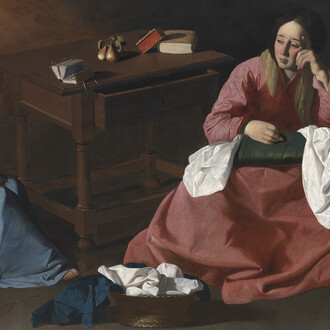Wakchakuna
We who share everything and nothing.(Excerpt from: And our faces, my heart, brief as photos by John Berger, 1984)
Nottingham Contemporary is pleased to present the first solo exhibition in an institution in England by Peruvian artist Claudia Martínez Garay (b. 1983 Ayacucho, Peru), who delves into her indigenous ancestry and the socio-political history of Peru in order to tell lost narratives from one of the world’s oldest civilizations. This major new commission celebrates the artist’s diverse practice with a new site-specific installation, her largest and most ambitious to date.
Martínez Garay studied printmaking in Peru, and her process of carving out, stencilling, and layering images in site-specific murals or free-standing sculptural objects exemplifies the influence of this early artistic training. Her practice, which encompasses painting, sculpture, video and installation, references pre-Columbian knowledge and her Andean heritage, and is inspired by historic images, propaganda, stories and sounds from her home country.
With her new commission, titled Wakchakuna, Martínez Garay addresses current debates around the belonging, originality and repatriation of stolen and looted objects that make up the ‘world’ collections in many UK museums; and speculates on the blank or erased spaces left by colonialism and conflict. The artist explores her complex relationship with Peru, revisiting her installation El creador (2019) - a work inspired by the belief in the afterlife of the Moche civilization, which flourished in northern Peru from about 100 to 700 AD - alongside new research into collections of historical and archaeological objects from the Americas within UK national collections.
The new work draws from the Quechuan term Wakcha, meaning ‘to be poor’: not in the Western sense of material wealth but meaning to be orphaned, without family, without belonging, without a community, and where one’s origins are made difficult to trace. The work is a further exploration of El creador, which consists of metal printed drawings of native Andean plants and ceramic replicas of Mochica ceramics held in European museums. A site specific installation, Wakchakuna consists of topsoil, sand and rubble, a collection of around 25 ceramic replicas and prints on aluminium featuring animals that were sacrificed by the Mochicas and buried with the deceased as offerings. Martinez Garay sees these as “orphaned objects”, who were separated from their funerary context, broken apart, faked to be sold, or stolen without a trace of where they come from, the origins are unknown and untraceable even while they have been unearthed and revealed.
Claudia Martínez Garay said: “Imagine how the ancient Peruvians would feel seeing our world today. Modernity has shamelessly disregarded their traditions and beliefs. Offerings and artifacts were stolen and stashed away in Europe, lost and robbed of their purpose. But just as the ancient cultures couldn't foresee our present, Europe can't conceive a future deprived of these artifacts."
Martínez Garay’s exhibition at Nottingham Contemporary coincides with her first solo exhibition in Scotland, opening at Dundee Contemporary Arts on 23 August – 17 November. A presentation of her work will also be shown at GRIMM, London (UK) during Frieze Week 2024.

















